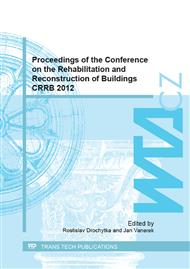p.158
p.165
p.172
p.176
p.180
p.185
p.193
p.201
p.207
3D Data for Calculation of Capillary Conductivity Coefficient
Abstract:
The moisture in building construction material affects the physical properties of buildings and he may lead to their degradation. With few exceptions, building materials are almost never dry. For the expected negative effect of moisture on building materials of structures is needed accurate method of determining the characteristics of their moisture as possible. The capillary conductivity coefficient characterizes transfer of liquid moisture in porous material. The method for its determination is experimentally arranged in such a way that it is possible to apply diffusion equation derived from the Luikov equation that is a phenomenological description of liquid moisture transport in porous materials as well as from the continuity equation, which expresses the classic conservation of matter principle. To records of the moisture distribution has been developed the methodology for measuring of moisture in the porous material, using microwave radiation. The calculation of the capillary conductivity coefficient and its dependence is based on the moisture curves in 3 D in non-stationary state of wetting, determined by non-destructive method.
Info:
Periodical:
Pages:
180-184
Citation:
Online since:
May 2013
Authors:
Keywords:
Price:
Сopyright:
© 2013 Trans Tech Publications Ltd. All Rights Reserved
Share:
Citation:


